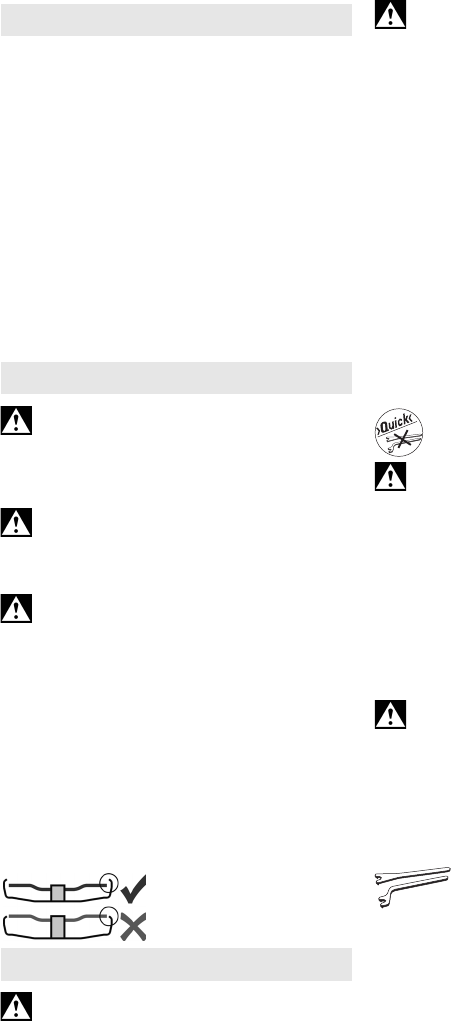
ENGLISH en
15
See page 2.
1 "Quick" clamping nut *
2 Support flange
3Spindle
4 Spindle locking button
5 Sliding
on/off switch *
6 Electronic signal indicator *
7 Speed adjustment wheel *
8Switch-on lock *
9 Trigger *
10 Additional handle / Additional handle with vibration
damping *
11 Safety cover
12 Clamping nut *
13 2-hole spanner *
14 Lever for safety guard attachment
* depending on equipment/not in scope of delivery
Before plugging in, check to see that the rated
mains voltage and mains frequency,
as stated on the rating label, match your power
supply.
6.1 Attaching the additional handle
Always work with the additional handle
attached (10)! Attach the additional handle
on the left or right of the machine and secure.
6.2 Install safety guard
For safety reasons, always use the safety
guard provided for the respective wheel! See
also chapter 11.
Safety guard for grinding
Designed for work with roughing wheels, flap
sanding pads, diamond cut-off wheels.
See page 2, illustration C.
- Push and hold the lever (14). Place the safety
guard (11) in the position indicated.
- Release the lever and turn the safety guard until
the lever engages.
- Push the lever and turn the safety guard until the
closed section is facing the operator.
- Make sure that the guard is seated securely: the
lever must engage and you should not be able to
turn the safety guard.
Use only accessories that
are covered by at least
3.4 mm by the safety guard.
Disconnect the mains plug before changing
any accessories. The machine must be
switched off and the spindle at a standstill.
For reasons of safety, attach the parting guard
before performing parting work
(see chapter 11. Accessories).
7.1 Locking the spindle
- Press in the spindle locking button (4) and turn the
spindle (3) by hand until the spindle locking button
engages.
7.2 Placing the grinding wheel in position
See illustration A on page 2.
- Place the supporting flange (2) on the spindle. The
flange should not turn on the spindle when
properly attached.
Only with W 8-100: Screw support flange with two-
pin spanner onto spindle so that the small collar
(with diameter 16 mm) is facing upwards.
Place the grinding wheel on the support flange (2).
The grinding wheel must lay flat on the supporting
flange. The metal flange on the parting grinder
disc must lay flat on the support flange.
7.3 Securing/Releasing the "Quick"
clamping nut (depending on features)
Securing the "Quick" clamping nut (1):
Do not use the
"Quick" clamping nut if the
accessory has a clamping shank thicker than 8
mm
! In this case, use the
clamping nut (12) with 2-
hole spanner (13).
- Lock the spindle (see chapter 7.1).
- Position the "Quick" clamping nut (1) on the
spindle (3) so that the 2 lugs engage in the
2 grooves on the spindle. See illustration on
page 2.
- Tighten the "Quick" clamping nut by turning
clockwise by hand.
- Turn the grinding wheel firmly clockwise to tighten
the "Quick" clamping nut.
Releasing the "Quick" clamping nut (1)
:
The "Quick" clamping nut (1) must be attached
before the spindle locking button (4) can hold
the spindle!
- The machine continues to run after switching off.
- Press in the spindle locking button (4) just before
the grinding wheel stops. The "Quick" clamping
nut (1) is released.
7.4 Securing/Releasing the clamping nut
(depending on features)
Securing the clamping nut (12):
The 2 sides of the clamping nut are different. Screw
the clamping nut onto the spindle as follows:
See illustration B on page 2.
- X) For thin grinding wheels:
The edge of the clamping nut (12) faces upwards
so that the thin grinding wheel can be attached
securely.
Y) For thick grinding wheels:
The edge of the clamping nut (12) faces
5. Overview
6. Commissioning
7. Attaching the grinding wheel


















